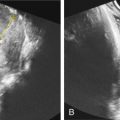Abstract
Fetal anatomy is three-dimensional, but cross-sections obtained during real-time ultrasound examination are merely an artificial reduction of anatomy. They attempt to capture a standard view or the essence of a particular pathology. Acquisition of a good ultrasound volume is not trivial, but a comprehensive volume may enable examination at a greater level of detail than is possible from a single cross-section. In this sense, volume ultrasound is similar to a video in that multiple different neighboring sections are displayed. This chapter explain how three-dimensional ultrasound can be used practically in obstetric imaging.
Keywords
3D ultrasound, advanced CNS evaluation, STIC, surface rendering
Introduction
Fetal anatomy is three-dimensional (3D). Cross-sections obtained during real-time ultrasound (US) examination are an artificial reduction of anatomy to produce one still image, created to capture a standard view or the essence of a particular pathology. Acquisition of a good US volume is not trivial, but a comprehensive volume may enable examination at a greater level of detail than is possible from a single cross-section; this is similar to a video in that multiple different neighboring sections are displayed.
Volume Displays
Three-dimensional US volumes can be analyzed visually in two principal ways: by viewing cross-sections or surface-rendered views. Cross-sections (planes placed anywhere in the volume) are viewed in either one single plane or two/three (typically orthogonal) planes. The latter is usually called multiplanar display ( Fig. 173.1 ). Before examining the anatomy, the multiplanar display should be used to align the volume according to standard planes ( Fig. 173.2 [face acquire, align]). A curved section can also be placed to follow anatomic structures that do not lie in a straight plane, such as the fetal palate ( Fig. 173.3 ). A display of a number of parallel cross-sections is usually called tomographic display ( Fig. 173.4 ). Surface-rendered views are formatted to display tissue interfaces, either of soft tissue (e.g., the facial skin surface, seen from the amniotic fluid cavity) or bone (e.g., the skull bones, seen from the outside or inside), or a mixture of both ( Fig. 173.5 ).





Technique
It is a misunderstanding and oversimplification to assume that any volume containing the structures of interest will enable extraction of diagnostic images. Three main aspects, each of which requires physical knowledge and careful execution, determine the diagnostic quality of successful 3D US: volume acquisition and alignment; volume contrast enhancement; and possibly, surface rendering.
Acquiring and Aligning a Volume
Successful 3D US first requires optimization of the two-dimensional (2D) image. The correct starting insonation angle with regard to the structure(s) of interest is of paramount importance. Not all sections that can be reformatted (extracted) from a 3D volume have the same resolution. In diagnostic US, the axial resolution (in the axis directed perpendicular away from the transducer) is better than the lateral resolution. Therefore the resolution in the acquisition plane (also called azimuth plane) is best; this plane is typically displayed in panel A directly after volume acquisition. The so-called range plane (blue plane in Fig. 173.2A ), which cannot be obtained in real-time scanning by simply rotating the transducer, offers the lowest resolution, yet it often contains valuable information that cannot be obtained by maneuvering the transducer on the maternal abdomen, or in case of transvaginal scanning, in the vagina.
The starting plane for a volume acquisition should be placed to show the structures of interest as well as possible. Then the volume is acquired and initially displayed in the multiplanar mode (showing three orthogonal planes: A, B, and C; Fig. 173.6 ). Each of these planes can be aligned, using rotation around the X, Y, and Z axes, respectively, to achieve the intended orientation, typically in standard anatomic sectional planes. A clinical example of this workflow for the fetal face is shown in Fig. 173.2 .


Stay updated, free articles. Join our Telegram channel

Full access? Get Clinical Tree








